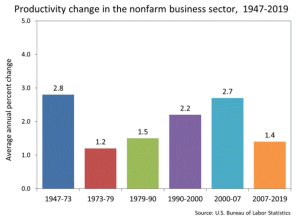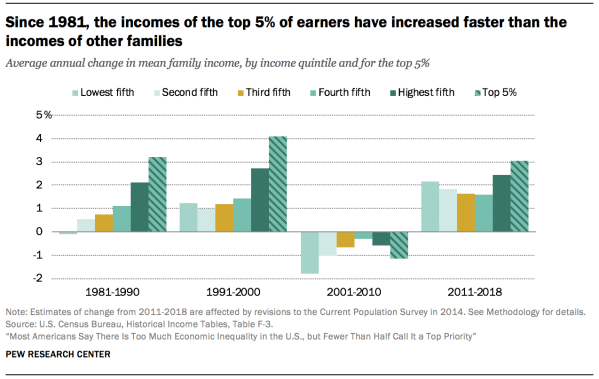Lots of discussion recently re: the impact of work from home (WFH) on the productivity of workers. The optimistic viewpoint is that managers will be forced to measure and drive output metrics rather than input metrics like “butt in seat” time. This should be good for the company and good for decreasing micro-management. A few pessimistic viewpoints are that employees are less focused on work in the home environment and that they are losing their attachment to the corporate mission due to physical separation. I will investigate both of those viewpoints further in future posts.
For now, this topic of productivity has re-kindled a wondering for me about why innovation and particularly exponential technological innovation has not been driving overall productivity gains in our economy. It seemed at the beginning of the digital era that we were on a correlated path of productivity acceleration (see chart below). But, then in the last 10 years we have seen the productivity growth number come back down to just 1.4%. This reversal is an unexplained mystery. There are schools of thought, but no clear agreement on why it is happening.
 Let’s take a step back and think about what Productivity is before considering an explanation for the trend.
Let’s take a step back and think about what Productivity is before considering an explanation for the trend.
Productivity is usually measured as the amount of labor input it takes to create a certain amount of goods/services output. It can be measured at a unit level, a company level, or even a country level. The numbers in the attached chart are for the whole US. However, some challenge this measure. All the way back in 1988, HBR published a good article talking about how the measure should be the sum of all inputs vs. the output rather than just the labor input. Vox also has a more recent article that starts to talk about some possible explanations for the drop.
Aspects of their explanation that make sense to me include the following:
Deflationary Tech: If some of the non-labor costs are decreasing, then in an output/labor ratio, one could imagine the deflationary influence lowering the numerator and therefore the overall ratio from what it would otherwise be.
Value not captured: “Output” is measured by quantity and price, not value. Yet, there is no doubt that enhanced versions of existing products and new step-change products are creating more incremental value than their price is increasing.
Or are we doing something wrong? Many WFH workers have been complaining about having to work longer and harder.
45 percent of remote workers say they regularly work more hours during the week than they did before, according to a 2020 survey of 2,800 workers by Los Angeles-based staffing firm Robert Half.
Yet, we are not seeing the fruits of that labor. Ideally, if the labor productivity goes up, it should provide some of that benefit back into the pockets of labor. Unfortunately though, more work does not always create more or better output. There is definitely a portion of the population getting rich, but it is not labor.

Are some people working smarter while others are not? Are our leaders encouraging the workforce to take time out and think about the hard problems and potential mis-directions or are they just pushing for heads down and run faster in the current direction? Many factors impact income disparity, this focus differential may be one.
Running faster, but not smarter makes me think about a social club concept called the Hash House Harriers. Their events include running courses where the faster runners end up going down dead ends and have to return back to the point where they branched off. The sudden return of the mis-directed, alerts the rest of the runners before they reach the dead-end and everyone returns to the correct path together. That is fun in a game context, but for business we should seek to shorten those dead-end branches so that the whole organization is more closely approximating the speed of the faster runners and lifting the productivity for all.
As a product manager, I spend a lot of our time out on “the course” with customers and potential customers trying to understand what path will create the fastest/greatest value. There is risk in almost everything, but we are looking for ways to either reduce risk or at the very least maximize the value/risk ratio. Product Management is a relatively new profession and in fact modern product management that includes hypothesis testing, MVP, A/B testing, and the like has only been around 15 years or so. My first exposure to it was Steve Blank’s “The Four Steps to the Epiphany“. Nerdy to admit, but it blew my mind back then.
Educators often claim that their goal is to teach students how to learn. I would like to see these product management concepts driven more and more from business schools down into university learning and even secondary school methods for all workers. Imagine a world where the majority of the workforce is thinking beyond the tasks in front of them towards increasing value and controlling risk along the way. What would that do to productivity?

